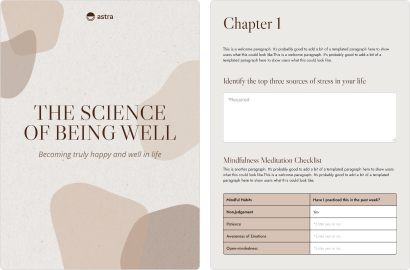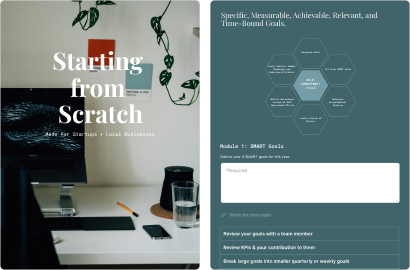There are five key elements to a productive coaching session. Your session should follow a logical flow that starts with a warm up that leads into goal setting. Then you get into the meat of your core coaching conversation before defining commitments and next steps on the client’s side, and a moment for reflection.
How these elements play out in your sessions will depend on the subject area of your coaching practice, your coaching style, and what the client is trying to achieve, but this generic framework is a great starting point for all life and business coaching.
1. The warm up
This is how you set the tone and create a safe space for your client to open up to you.
How to kick off your coaching session
Just because you’re easing into the session, doesn’t mean there isn’t a way to start the work. There are two open ended questions that many coaches rely on to get the ball rolling.
“What’s on your mind?”
This seemingly innocuous question will get your client to highlight the purpose of the coaching session, whether they’re fully switched on to that or not.
“And what else?”
This keeps the conversation going and will help you move towards the nut of the conversation. It will help you uncover deeper insight while buying time when you’re discussing complex issues.
2. Goal setting
Your warm up should have indicated some areas to work on during the session. Set goals for your time together and make sure that you’re both aligned on the issue that requires work, and what the desired outcome is.
3. Coaching
It’s game time! This is where you leverage your techniques and strategies to help your client get to the ‘aha!’ moment. Depending on your coaching style, this might be where you incorporate anecdotes, examples, role playing, roadmaps, or other resources into the session.
4. Defining commitments
The work doesn’t stop when your meeting ends. Identify the action items your client will commit to taking to help change their habits or work toward their desired goals.
5. Reflection
It’s important to keep the session success vibes going beyond your time together. Once all the tough stuff is done, reflect on the breakthroughs you achieved together. Summarize the wins to reinforce the learnings and maintain the forward momentum.
Wobo is built with reflection and engagement in mind. Leverage Wobo’s advanced functionality to ask open ended questions for the client to add their reflections and learnings into their digital workbook. And because coaching is about continuous learning, Wobo has the unbeatable ability to pick up where you’ve left off to keep the reflection party going over long periods of time.
What makes a good coaching session?
Defining success is just as important for you as a coach as it is for your client. Not unlike during your coaching interactions, this will come down to how you answer some big questions.
Are your clients learning or moving towards achieving their goals? Do they leave the sessions feeling motivated? Are you equipping them with the tools they need to move forward? Do you have the coaching tools in place to facilitate and track the next stage of their growth?

